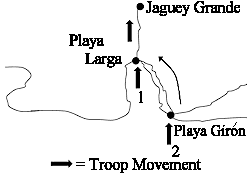|
| |

The Bay of Pigs Invasion

Cuban exiles attempted to invade Cuba in April of 1961. The exiles
were supported and trained by the United States government to overthrow Fidel Castro and
his leftist regime. The battle took on the name of the bay on which the invasion took
place--the Bay of Pigs. The invasion was unsuccessful, due largely because the Cuban
people supported Castro's revolution and in part to the limited role that the United
States government played during the battle The invasion attempt further intensified the
tension between the United States and Cuba.
Even before the Bay of Pigs invasion, friction between the United
States and Castro’s leftist regime was high. President Eisenhower broke off
diplomatic relations with Cuba in January of 1961. Before that, the Central Intelligence
Agency had been training anti-revolutionary Cuban exiles in Guatemala for a possible
invasion of the Cuban Island. After the election of President Kennedy, the plan for
invasion continued with minor, yet significant alterations.
 On
April 17,1961, more than 1,300 exiles armed with U.S. weapons landed in la Bahia de
Cochinos, the Bay of Pigs, on the Southern Coast of Cuba. The assault began at
approximately 2:00 AM with a team of frogmen going ashore to set up equipment. At 2:00 and
3:00 AM, two battalions came ashore at Playa Giron, while another battalion landed at
Playa Larga. The troops at Playa Giron had orders to move northwest up the coast and meet
with the troops at Playa Larga in the middle of the bay. From this point, the troops were
prepared to move Northward to the city of Jaguey Grande. However, these plans were never
carried out because the invasion was met and stopped by Castro’s overwhelming
military might. On
April 17,1961, more than 1,300 exiles armed with U.S. weapons landed in la Bahia de
Cochinos, the Bay of Pigs, on the Southern Coast of Cuba. The assault began at
approximately 2:00 AM with a team of frogmen going ashore to set up equipment. At 2:00 and
3:00 AM, two battalions came ashore at Playa Giron, while another battalion landed at
Playa Larga. The troops at Playa Giron had orders to move northwest up the coast and meet
with the troops at Playa Larga in the middle of the bay. From this point, the troops were
prepared to move Northward to the city of Jaguey Grande. However, these plans were never
carried out because the invasion was met and stopped by Castro’s overwhelming
military might.
Upon their arrival in Cuba, the troops expected to gain the support of
their fellow Cubans yet this support was not shown and Castro’s air power proved to
be effective. Castro's airforce sunk the US command vessel, Marsopa, and supply
ship, the Houston. By the time the fighting ended more than 90 exiles had been killed and
the rest taken prisoners.
A 150 page internal investigation of the Bay of pigs blamed its
failure on the CIA’s poor handling of the invasion. The report cited the CIA for,
among other things, misinforming officials in the Kennedy administrations, poor planning,
and using faulty intelligence. CIA officials and Cuban exiles believed Kennedy’s
failure to approve air strikes to back up the invaders never gave the mission a chance to
be successful.
The Bay of Pigs invasion made Castro wary of the United States. He
believed the Americans would try to take over the island again. Because of his fear when
the Soviets agreed to take the missiles out of Cuba, one of the terms was that the U.S.
could not attempt to invade again.

|